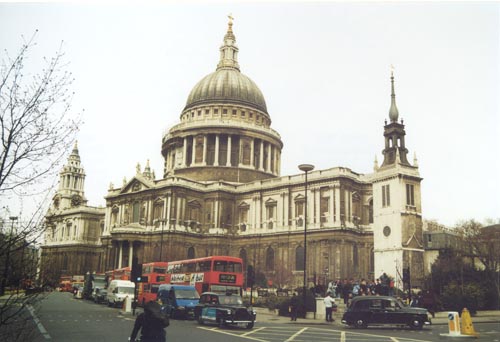
24 March 1998 6:40am
Woke up, fell out of bed,
dragged a comb across my head ...
I was up at 6:15, actually. I turned on the telly, James Cameron was saying something about, "You've all made this such a success." He sounded very happy. I'm guessing Titanic did good at the Oscars. It did. I took a shower, and when I came back, I learned that Titanic won Best Film, Jack Nicholson won Best Actor, Helen Hunt for Actress, Robin Williams for Supporting Actor, and Kim Basinger for Supporting Actress.
6:57am - Time to go. I figure I'll go over to St. Paul's or the Tower of London, and take it from there.

I took the Central Line from Queensway to St. Paul's, came out right across from the Cathedral, and went, "Yow." It's just amazing. Huge, of course. Talk about dominating the area.
I walked around the building a bit, wondering if there was a visitor's entrance besides the main doors, which are very large and very closed, at least at 8:30 in the morning, when I got there. Fortunately, there is a visitor's entrance for a self-guided tour, and, even more fortunately, they were just opening up as I got there.
I was the third person to enter the building, if you don't count the ticket seller, so I pretty much had the place all to myself. What a way to start the morning!
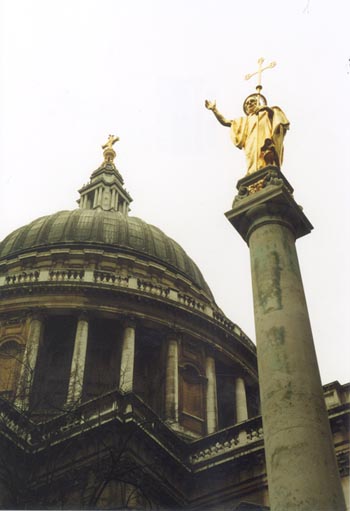
Verbatim entry in my journal, words having failed me as I took in St. Paul's:
8:37 AM in St. Paulís -
Truly Glorious.
Am standing under the Dome.
Very quiet, very few people. Just opened at 8:30.
Plaque under the dome reads:
Subtus Conditur Huius Ecclesiae Et Urbis Conditor
Christophorus Wren Qui Vixit Annos
Ultra Nonaginta Non Sibi Sed Bono Publico
Lector Si Monumentum Requiris Circumspice
Obiit XXV Feb Aetatis XCI Ano MDCCXXIII
My Latin is pretty terrible but I can sort of translate the last two lines. Basically the fourth line says, "Reader, if you seek a monument, look about you." Wren didn't want an elaborate monument in the crypt, where he was buried; his son wrote the words for his memorial. Quite fitting.
And the last line says, "Died 25 February at the age of 91, in the year 1723." I hope I wrote down the Roman Numerals correctly, that's what I translate it as.
Wren is now one of my personal heroes. This guy was truly amazing! As for what the books say about him:
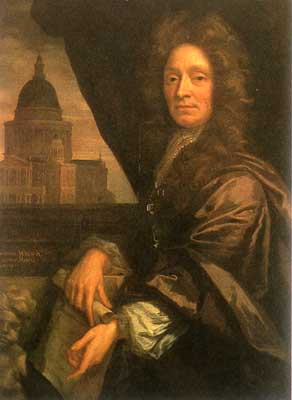 Sir Christopher Wren
Sir Christopher Wren
Wren is remembered as England's great architect; he also wrote five unpublished commentaries on the theory of architecture. Before the fire of London turned him decidedly to architecture, he was a leading scientist although he published almost nothing. However, Isaac Newton, never one to give excessive praise to others, states in the Principia that he ranks Wren together with Wallis and Huygens as the leading geometers of the day.
Wren attended Westminster School, London. He entered Wadham College, Oxford in 1649 and received an M.A. from Oxford in 1653. In 1657 he became professor of astronomy at Gresham College, London, and contributed to the advance of optics. He published a description of a machine to create perspective drawings and he discussed the grinding of conical lenses and mirrors.
Wren was the leader of a scientific discussion group at Gresham College London that, in 1660, initiated formal weekly meetings. In 1662 this body received its Royal Charter from Charles II and 'The Royal Society of London for the Promotion of Natural Knowledge' was formed. Wren was president of the Royal Society from 1680 to 1682.
Wren became Savile Professor of Astronomy at Oxford in 1661 and held this post until 1673. His interests proved to be architecture and geometry as well as astronomy.
In 1663 he designed the chapel at Pembroke College, Cambridge; in 1664, the Sheldonian Theatre, Oxford; and in 1665, buildings for Trinity College, Oxford. His most famous work of architecture is, of course, Saint Paul's Cathedral.
On the night of September 2nd, 1666, having been wracked by plague for two years, the City of London burned down. Starting in a baker's shop on Pudding Lane and fanned by an easterly wind, the Great Fire roared through London's timber-framed heart, jumping from street to street for five days, until most of the medieval city was utterly destroyed. In all, some 13,000 houses were burned to the ground, as well as 89 churches, among them being the great gothic cathedral of St. Paul's.
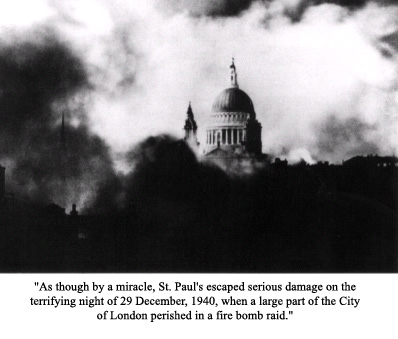
Sir Christopher Wren, mathematician, engineer and architect of genius, devised a scheme for rebuilding the City which would have given London a grandeur and magnificence unexcelled in Europe, but the landlords couldn't wait. Greedy for rents, they threw up new buildings, though this time in brick and to a uniform height, restoring the tortured old pattern of shut-in streets and alleys. Wren's part, in the end, was to rebuild the churches, which he did -- 51 of them, including the new St. Paul's, his gigantic, magnificent but still humanly scaled triumph.
I couldn't have said it better myself. Truly amazing. And Wren was only 41 when he began work on St. Paul's. Genius.
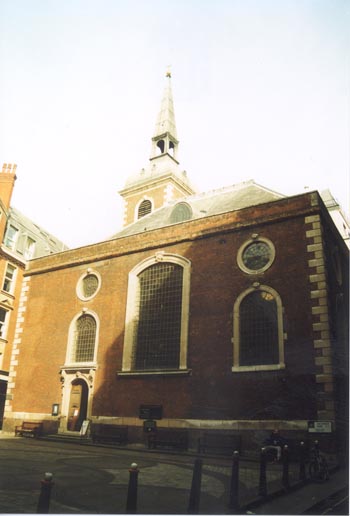 After being duly impressed, yet also
spiritually comforted, by St. Paul's, I took a short walk down Abchurch Lane,
looking for a little church named St. Mary Abchurch. Why was I looking for it?
As Donald Goddard wrote in Blimey!, a splendid guide to London:
After being duly impressed, yet also
spiritually comforted, by St. Paul's, I took a short walk down Abchurch Lane,
looking for a little church named St. Mary Abchurch. Why was I looking for it?
As Donald Goddard wrote in Blimey!, a splendid guide to London:
About 200 yards south of [St. Michael's Alley], down Birchin Lane, right on Lombard Street, then left on Abchurch Lane, crossing King William Street, you pass St. Mary Abchurch on the right. Turn then and confront one of the simplest yet most appealing sights in London.
What was once St. Mary's graveyard is now a pie-slice of pavement with seats and flower boxes. With its neighbors thus held back along a diagonal building line, the church presents its flank to passers-by, a quiet and lovely elevation of dark brick weathered to purplish brown, stone-dressed, with a plain doorway and windows in subtly balanced asymmetry.
Wren, of course. No other London architect could have built a brick barn, pierced it with such easy assurance, added a simple tower and spire and wrung an answer from the gut of anyone who cared to use his eyes for the next 300 years. St. Mary Abchurch is a work of genius, a gentle conception almost perfectly fulfilled. Inside, he circles the square with a shallow painted dome, dark in tone though flooded with light, and in the open space beneath, the woodwork flowers most splendidly under the hand of Grinling Gibbons -- the real thing for once; a tremendous altarpiece and pulpit top fit to eclipse an archbishop. There are more important buildings, no doubt, where Wren aimed higher and achieved no less, but none that command more affection.
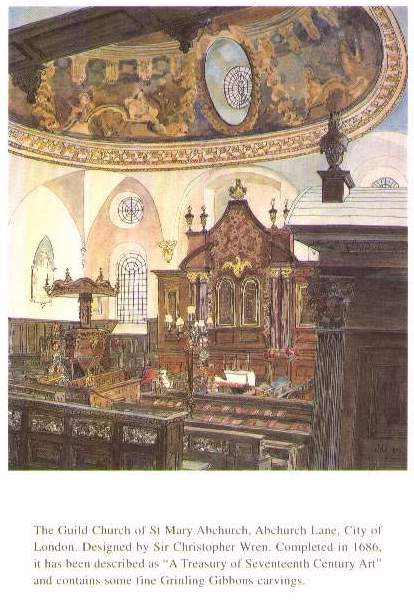
It is truly a place for the spirit. I had the entire church to myself, and I just sat in the back row pew and marveled.
Before I sat down, though, I went to the back of the church and saw a small table for guests to sign in, and where one could purchase postcards of St. Mary's for 50p, and the picture you see here is that very postcard. I dropped a pound coin in the slot; it was the least I could do.
As I was signing the guest book, my camera bonked the table, rather loudly, and a little old guy came out of the back room. I was embarrassed, and expected a short lecture on being careful in this old building (a brief history sheet next to the guest book noted that the church was "rebuilt by Wren 1681-1687"), but he was just a very neat guy, I guess some kind of caretaker, who was surprised to see anybody coming in on this weekday morning.
The fact that I was an American, and had come to see this little church deliberately, instead of just having stumbled across it, really made his day. He talked on and on about the church, and I wish I'd had a tape recorder because I would have loved to capture both his words and his accent to share.
From what I remember, he told me to look up at the dome, and see "if I noticed anything." I didn't, and I said so, nervously, and he just happily told me that the dome has no external buttresses, and so appears to be "floating" in the air. Ah, Wren!
Because there is also no internal architecture to interfere with the smoothness of the unbroken dome inside, the painting inside the dome is just that much more spiritual and uplifting. I wish I'd been able to take a photograph, but it was too dark inside and I didn't want to use a flash.
There is a choir of angels, all reaching towards the center of the dome, towards God ... and in the center is simply a circle with the letters YHVH insides, the Hebrew word for Yahweh, "I Am Who Am." I think it's just lovely -- all this wonderful art and architecture leading us to this point where we have to find God with our own eyes, and hearts. Lovely.
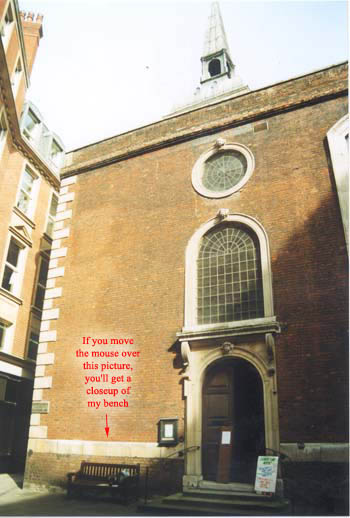
24 March 1998 10:37am
[Another verbatim entry in my log]
What a lovely, lovely day!
Am sitting in the churchyard of St. Mary Abchurch ... sun is coming over the rooftops. Wow! Started morning with breakfast sandwich from Harts, stopped by little Catholic Church (St. Mary?) on Queensway, thought about Mass, felt out of place. Went to bus stop, decided to take Tube instead.
Went to St. Paul's, cute girl on Tube. Exit St. Paul's. AMAZING! Ooh, cold wind ... new film in camera, several photos, grand tour of church £4, didn't go to galleries. Saw Wren's tomb, Nelson's, bought postcard of wartime, great shot. Neat loos!
Poster of Wren for Tercentenary, £1.95. Walked toward Ludgate Rd., wrong way, looking for Abchurch. Bought SBC [Seattle's Best Coffee] coffee, mocha, £2, ugh! Not Seattle's Best! Down to Abchurch. Beautiful little church! Taking a rest in the churchyard. On to? ...
11:22am
I got yet more lost after St. Mary Abchurch, but managed to finally find a Tube stop, Cannon Street, which, fortunately, was direct on the Circle Line to the Embankment, where I wanted to go.
The embanking of the River Thames was a landmark in sanitary reform and a major achievement in Victorian engineering. The undertaking was first proposed by -- whom else? -- Christopher Wren, but nothing was done till after the summer of 1858, when the stench in the Houses of Parliament made only too obvious the absence of a low-line main sewer.
So what's an embankment?
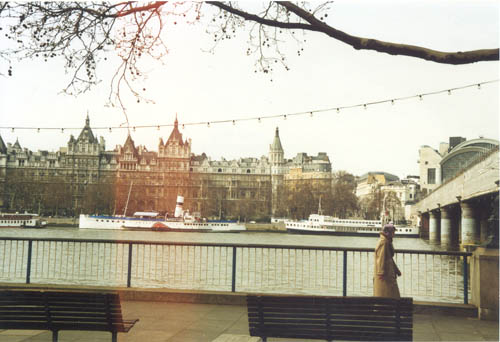
The Embankment is Westminster's river frontage downstream from Westminster Bridge, and it is arguably one of the world's most handsome riverscapes. Sweeping for almost half a mile along the north bank of the river around a long right-hand curve, the Embankment is backed by the facades of some notable buildings - among them Portcullis House, the Ministry of Defence, the Adelphi, the Savoy and Somerset House. Much of the present embankment is of recent construction, the Thames having been forced into a narrower channel to accommodate both the road and London Underground's District Line, constructed around 1870.
The work was carried out by in three stages; the Victoria
Embankment on the north side, one and a quarter miles long, was completed
between 1864-1870; the Albert Embankment on the south side (I took the above
picture of the Victoria Embankment from along a stretch of the Albert
Embankment), just under a mile long, was built between 1866-1869; and the
Chelsea Embankment, nearly three-quarters of a mile, was constructed between
1871-1874.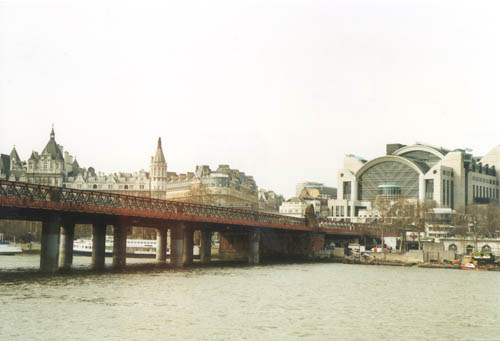
So I found the Victoria Embankment -- and you're looking at some more of it. Actually you're looking at the National Liberal Club buildings on the left, Hungerford Bridge in the middle, and Charing Cross rail station on the right, but in front of all of that is The Embankment. There's a park here, too, or, rather, the Victoria Embankment Gardens, on the left, behind the bridge.
I wanted to walk along the Thames, just for the heck of it, plus to see the city, and seeing all the bridges along the way was just frosting on the cake. I decided to walk from Waterloo Bridge to Tower Bridge, which seemed like a nice distance.
Except I thought Waterloo Bridge was near Cleopatra's Needle and the Embankment, which it sort of is, but really it's further east, so I went too far. But it was worth the extra walk.
There's a beautiful park right outside the Tube stop, and
Cleopatra's Needle is only a bit farther, right on the river's edge. It
was turning into a truly gorgeous day so I had a great time wandering around.
So did about a zillion other tourists, but with these sights, who could blame
them?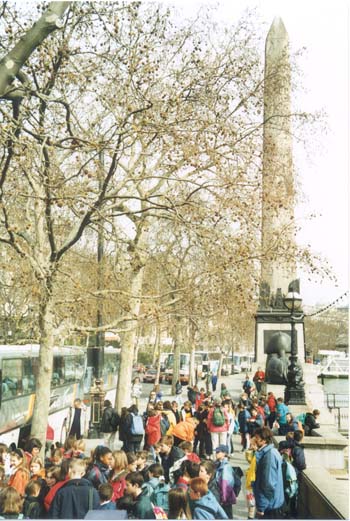
I walked up to Charing Cross Station, which is a major train terminus and an extremely impressive work of architecture, to boot. Then I walked back to the Needle, which has no historical connection with the fabled queen; I guess they just liked the name. The pink granite obelisk, 68 1/2 feet high, was actually erected about 1500 BC by Thothmes III near Heliopolis and was later removed to Alexandria. A plaque on the base reads:
THIS OBELISK
ON THE SANDS OF ALEXANDRIA
WAS PRESENTED TO
THE BRITISH NATION AD 1919
BY MAHOMMED ALI
VICEROY OF EGYPT
OUR DISTINGUISHED COUNTRYMEN
NELSON AND ABERCROMBY
My book on London makes the additional notation: "It ... was brought to London, with great difficulty, 'through the patriotic zeal of Erasmus Wilson, F.R.S.', in 1878." I'll bet there's a great story in there somewhere.
More little known facts: It is claimed by some sources that Cleopatra's Needle represents the point from which all road distances to London are measured. (I wonder if the Trafalgar Square people know about this). Also, the Needle has a twin in Central Park, New York
I showed up at the Embankment just about the same time as a few zillion Spanish school kids (as you might be able to tell from the above picture), apparently on some kind of tour. They were all well behaved and photogenic so I snapped a few photos of them. I think 98% of the people in my London photos aren't actually from London. Oh, well.
There's a plaque at the base of the bridge, which I thought was Waterloo Bridge but actually turned out to be Hungerford Bridge, in honor of W.S. Gilbert, of "Gilbert and Sullivan" fame. The plaque reads:
1856 W.S. Gilbert 1911
Playwright & Poet
His Foe was Folly
& His Weapon Wit
I think I'd like that on my tombstone, too. Except with my name, of course, and not for a few more years!
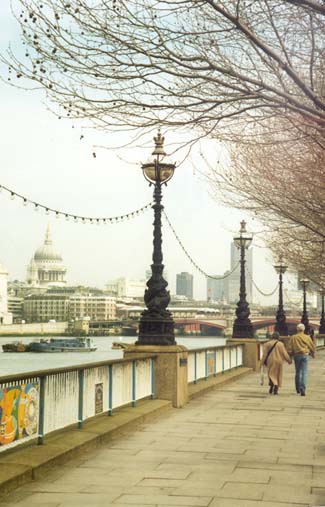
If you really want to see London, the best way is on foot -- the Thames has paths ("The River Walk") that offer sights you just can't find anyplace else. If you've only got a day to spend, I highly recommend the walk from Lambeth (or Westminster) Bridge to Tower Bridge, but if you've got more time you've got about 180 miles of river you can walk, with trails even. Wear comfy shoes!